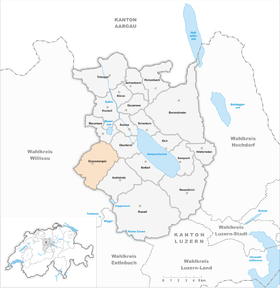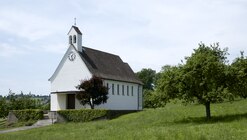Big cheeks
| Big cheeks | |
|---|---|
| State : |
|
| Canton : |
|
| Constituency : | Sursee |
| BFS no. : | 1086 |
| Postal code : | 6022 |
| Coordinates : | 646 383 / 220442 |
| Height : | 547 m above sea level M. |
| Height range : | 523–747 m above sea level M. |
| Area : | 19.70 km² |
| Residents: | 3241 (December 31, 2018) |
| Population density : | 165 inhabitants per km² |
|
Proportion of foreigners : (residents without citizenship ) |
11.9% (December 31, 2,015) |
| Website: | www.grosswangen.ch |
| Location of the municipality | |
Grosswangen is a municipality in the Swiss canton of Lucerne . It lies in the constituency of Sursee .
geography
Grosswangen is about 25 km northwest of Lucerne . The region around Grosswangen, Buttisholz and Ruswil is also called Rottal after the stream Rot . The highest point in the municipality is the upper height at 747 m above sea level. M. , the deepest near the Buchwald nature reserve at 523 m above sea level. M.
78.3% of the municipal area of 19.7 km² is used for agriculture, 15.3% of the area is covered with forest and wood and 5.9% is settlement area.
Grosswangen borders on the following communities: in the north on Mauensee and Oberkirch , in the east on Buttisholz , in the south on Menznau and Willisau and in the west on Ettiswil .
population
| Population development | |
|---|---|
| year | Residents |
| 1745 | 1'540 |
| 1810 | 1,842 |
| 1850 | 2,724 |
| 1900 | 2,035 |
| 1950 | 2,436 |
| 1970 | 2,213 |
| 1980 | 2,235 |
| 1990 | 2,446 |
| 2000 | 2,731 |
| 2004 | 2,837 |
| 2008 | 2,931 |
| 2010 | 2,959 |
In the almost 100 years from 1745 to 1850, the number of residents increased considerably (1745–1850: +76.9%). In the second half of the 19th century, Grosswangen was also drawn into the maelstrom of rural areas to industrial centers. Hundreds left the village (1850–1900: −25.3%). In the next 50 years there was a slight but steady growth (1900–1950: + 19.7%). From 1950 to 1970 there was a second, but much smaller wave of emigration than in the 19th century (1950–1970: −9.2%). Since 1980 there has been a steady population growth (1980–2004: +26.9%), so that the (former) population high of 1850 has now been exceeded.
languages
The population uses a highly Alemannic dialect in everyday life . In the last census in 2000, 95.63% said German, 3.88% Albanian and 0.48% Portuguese were the main languages.
Religions - denominations
In the past, all residents were members of the Roman Catholic Church. Today (as of 2000) the religious landscape looks like this: There are 86.34% Roman Catholic, 4.76% Evangelical Reformed and 0.33% Free Church Christians. There are also 3.15% Muslims and 2.27% non-denominational.
Origin - nationality
At the end of 2014, of the 3,104 inhabitants, 2,723 were Swiss and 381 (= 12.3%) were foreigners. The population consisted of 87.7% Swiss citizens. At the end of 2014, the foreign residents came from Serbia including Kosovo (46.5%), Germany (18.1%), Portugal (6.6%), Italy (6.0%), Spain (1.6%) and the Turkey (0.5%). 11.3% came from the rest of Europe and 9.4 % came from outside Europe.
history
Remains of a Roman military station from the 1st century and Alemannic graves from the 7th century have been excavated in the community. In 893 the place was first mentioned under the name Wanga in the interest register of the Fraumünster Abbey in Zurich. From the 12th on, Grosswangen belonged to the so-called Äusseren Amt Wolhusen of the barons of Wolhusen. From 1295 the Habsburgs exercised supremacy, the barons of Wolhusen continued to administer the place until 1389. The various castles of that time have all been destroyed and disappeared. After the city of Lucerne gained more and more influence after the Battle of Sempach in 1386, the Habsburgs sold the entire Outer Office of Wolhusen to Lucerne on Whit Monday 1405. The community then belonged to the Ruswil Landvogtei until 1798. She took part in the Peasants' War of 1653. From 1798 to 1803 Grosswangen formed part of the Helvetian district of Willisau. Since that time the place has belonged to the office created at that time or today's constituency Sursee .
politics
Municipal council
The Grosswangen Municipal Council consists of five members and is set up as follows:
- Beat Fischer: Mayor
- Brigitte Bösch: Social
- Josef Doppmann: Construction
- Cornel Erni: Finances
- Monika Meier-Böll: Education
Cantonal elections
In the 2015 Cantonal Council elections for the Canton of Lucerne, the share of the vote in Grosswangen was: CVP 40.2%, FDP 28.6%, SVP 21.7%, SP 5.9%, glp 1.9%, GPS 1.4%.
National Council elections
In the 2015 Swiss parliamentary elections, the share of the vote in Grosswangen was: CVP 34.5%, SVP 27.6%, FDP 25.5%, SP 4.7%, glp 3.2%, Greens 3.0%, BDP 0, 9%.
traffic
Since the project of the Rottalbahn, which was planned at the beginning of the 20th century, was never realized, the community is connected to the public transport network by bus. The Lucerne (-Bahnhof) -Ruswil- Ettiswil line operated by Rottal Auto AG provides access to the community.
Grosswangen is on the main road Emmenbrücke- Ettiswil-Dagmersellen. The closest motorway connections are Sursee 9 km and Dagmersellen 12 km away, both on the A2 .
Personalities
- Edouard Huber (* 1879 in Grosswangen; † 1914 in Vinh Long, Vietnam), language scholar, sinologist and Indochina researcher
- Gregor Bucher OSB (* as Theodor Bucher 1935 in Grosswangen; † 2019 in Engelberg), Benedictine, professor of philosophy in Chur and Rome
Attractions
photos
Hamlet of Stettenbach (Stättebach)
literature
- Walter Frey: Grosswangen. In: Historical Lexicon of Switzerland .
- Adolf Reinle : The art monuments of the canton of Lucerne. Volume IV: The Sursee Office (= Swiss Art Monuments. Volume 35). Edited by the Society for Swiss Art History GSK. Bern 1956, ISBN 978-3-906131-23-8 .
Web links
- Official website of the community of Grosswangen
- Community profile of the cantonal statistical office (PDF, 116 B)
Individual evidence
- ↑ Permanent and non-permanent resident population by year, canton, district, municipality, population type and gender (permanent resident population). In: bfs. admin.ch . Federal Statistical Office (FSO), August 31, 2019, accessed on December 22, 2019 .
- ↑ Permanent resident population according to nationality category, gender and municipality ( memento of the original from January 1, 2015 in the Internet Archive ) Info: The archive link was inserted automatically and has not yet been checked. Please check the original and archive link according to the instructions and then remove this notice. (Permanent resident population)
- ↑ Balance of the permanent resident population according to demographic components, institutional structure, nationality and gender (Federal Statistical Office, STAT-TAB)
- ↑ LUSTAT: Community profile Grosswangen ( Memento of the original from May 8, 2016 in the Internet Archive ) Info: The archive link was inserted automatically and not yet checked. Please check the original and archive link according to the instructions and then remove this notice.
- ↑ LUSTAT: Community profile Grosswangen ( Memento of the original from May 8, 2016 in the Internet Archive ) Info: The archive link was inserted automatically and not yet checked. Please check the original and archive link according to the instructions and then remove this notice.
- ↑ National Council elections 2015: strength of the parties and voter turnout by municipality. In: Results of the National Council elections 2015. Federal Statistical Office, 2016, accessed on May 31, 2016 .








